After WWII, the victorious Allies divvied up most of the surrendered Italian navy. The USSR received the battleship Giulio Cesare which was renamed Novorossiysk. Later rated as a training ship, Novorossiysk sank on 29 October 1955 in what is the largest-ever Soviet or Russian peacetime naval disaster. The mystery surrounding the ship’s loss has never been solved.
(The battleship Giulio Cesare in service with the Italian navy during WWII, and as the training ship Novorossiysk under the Soviet flag after the war.)
Origin of the ship and rebuild
One of three Conte di Cavour class battleships, Giulio Cesare (Julius Caesar) was launched on 15 October 1911 and commissioned on 7 June 1914. In service throughout WWI, Giulio Cesare took no meaningful part in that war. (However one of her two sister-ships, Leonardo da Vinci, sank in 1916.) As completed, Giulio Cesare was typical of a WWI battleship, displacing 25,489t and measuring 577’5″x91’10″x30’6″. The main armament was eleven 12″ guns in five (three triple, two twin) turrets, plus some obsolete anti-surface casemate guns and three nearly useless fixed torpedo tubes. The maximum speed was 21 kts and the crew was 1,000.
In 1928, the obsolete Giulio Cesare was mothballed due to the Great Depression. In October 1933, it was decided to modernize the two remaining battleships of this class. The “modernization” was in fact a complete bow-to-stern rebuild, one of the most massive ship reconstructions ever, which left the vessels barely recognizable as their former selves. The project was immensely difficult and expensive, more so than simply building new battleships. One of the reasons for the project was that new construction was limited by arms control treaties, however “modernizations” did not count as new ships, even if they were this drastic.
 (Giulio Cesare before and after the drastic rebuild which completely transformed the battleship’s appearance.)
(Giulio Cesare before and after the drastic rebuild which completely transformed the battleship’s appearance.)
The modernization lasted from October 1933 to October 1937. The end result was a fairly impressive, modern (for the time) battleship. The displacement was now 29,600t and the ship now measured 611’7″x108’7″x34′. The engine room was completely changed. Giulio Cesare was now powered by eight Babcock & Wilcox boilers with two Yarrow geared steam turbines, turning two shafts with three-bladed propellers. Despite all of the added size and tonnage, this allowed the maximum speed to be greatly increased from 21 kts to 27 kts.
The ship was now heavily armored, with a 9 ½” belt, 6 ½” deck, and turret faces of 11″; while the entirely new massive conning tower had 10″ armor. The weapons fit was completely changed. The amidships turret of the original design, which had a restricted firing arc, was eliminated, as were the torpedo tubes. Instead the main gun fit was now four (two triple, two twin) OTO M1934 12.6″ guns. These had a range of 15 ¼ NM and each individual barrel had 100 round of ammunition. The secondary weapons were also changed. All of the obsolete casemate guns were eliminated. Instead, six twin OTO M1933 120mm dual-purpose turrets were fitted, along with eight 100mm and six twin 37mm and twelve twin 20mm anti-aircraft weapons, plus a dozen Breda M31 machine guns. The ship’s complement increased to 1,260.
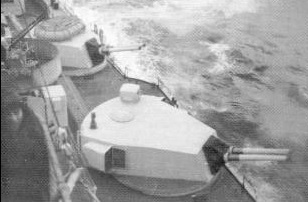 (Two of the OTO M1933 twin dual-purpose turrets installed during the rebuild.)
(Two of the OTO M1933 twin dual-purpose turrets installed during the rebuild.)
The conversions were successful and these WWI-era hulls were now good battleships by 1930s standards. The French navy was unhappy as it felt Mussolini was “gaming the system” regarding the arms control treaties (which he was) but there was nothing that could be done.
During WWII
On 9 June 1940, Giulio Cesare was on the receiving end of a bit a naval history, when a 15″ shell from the British battleship HMS Warspite scored a hit at 14.8 NM range; the longest-ranged gun hit ever between two moving objects. Otherwise, the Italian ship took no real meaningful part in the war.
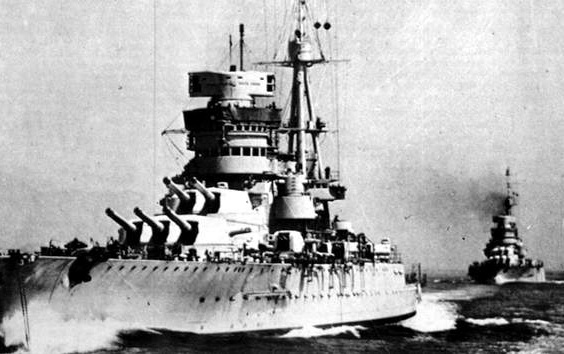 (Giulio Cesare and her sister-ship Conte di Cavour during WWII. The object atop the conning tower was an optical rangefinder for the main guns.)
(Giulio Cesare and her sister-ship Conte di Cavour during WWII. The object atop the conning tower was an optical rangefinder for the main guns.)
The armistice
On 3 September 1943, the Italian king and prime minister signed an armistice with the Allies, which of course was not honored by Mussolini’s fascists, some of who continued to fight until the end of WWII. The disposition of the Italian navy was a key point, especially to Great Britain, as Italy’s fleet was (on paper anyways) still formidable. Depending on where they were on the day of the armistice, Italian warships were ordered to go to either Valletta, Malta; or Taranto, Italy; which the Allies secured six days after the armistice. At the time, Giulio Cesare was in a reduced operating status and being used as a training battleship, and proceeded to Taranto as instructed. A significant portion of the crew were pro-fascist and the captain had to deal with an attempted mutiny and violence between shipmates during the voyage.
After a failed German u-boat attack and further crew problems, Giulio Cesare was moved to Valletta where the battleship remained until June 1944, when the British ordered her back to Taranto, now safely far away from the front lines.
Post-WWII dispersion of the Italian navy
In October 1943, about a month after the Italian armistice, the Soviet diplomat Vyacheslav Molotov relayed to the USA’s Secretary of State, Cordell Hull, an immediate claim by the USSR on a portion of the Italian navy. Specifically the Soviets demanded one each of a battleship and cruiser, plus a number of smaller warships.
The “pinch-hitter”
The USSR’s leader, Josef Stalin, was adamant that the Italian war prizes be transferred immediately to avoid the impression that the Western Allies were treating his country as a second-rate ally.
 (The battleship HMS Royal Sovereign, here in Soviet navy colors as Arkhangelsk during the “loaner” period.)
(The battleship HMS Royal Sovereign, here in Soviet navy colors as Arkhangelsk during the “loaner” period.)
Because WWII was still going on, it was impossible to sail the Italian ships to the USSR. In December 1943, it was agreed that equivalent western battleship and cruiser would serve as stand-in’s for the Italian vessels until WWII ended. The British and American navies chose two of their most woefully obsolete warships, the battleship HMS Royal Sovereign and cruiser USS Milwaukee, as the “loaners”.
HMS Royal Sovereign was transferred on 30 May 1944 and renamed Arkhangelsk. During the final part of WWII, Arkhangelsk served as the Soviet arctic flagship and an ineffective convoy escort. The loan expired in January 1949 and on 4 February 1949, Arkhangelsk was returned to Great Britain. The battleship was in atrocious condition, apparently having received almost zero maintenance in Soviet service. One of the aft main gun turrets was rusted in place at 0° bearing, indicating it had not even been operated let alone maintained. Arkhangelsk had run aground in 1947 and the lower hull was barely patched up. The British immediately scrapped the ship. (Curiously, USS Milwaukee was returned to the US Navy at the same time in good condition.)
Italian battleship strength after WWII
Five Italian battleships survived the end of WWII in 1945: both Andrea Doria class ships (Andrea Doria and Caio Diulio) moored at Syracuse, Italy; two of the three Littorio class ships (Italia and Vittorio Veneto) which were damaged from the war and parked in the Great Bitter Lake passing lane of the Suez Canal; and the last surviving Conte di Cavour class ship, Giulio Cesare, moored at Taranto, Italy in lay-up status.
The Four-Power Commission
The actual treaty which formally ended WWII for Italy, the Peace Of Paris, was signed on 10 February 1947.
 That month, naval representatives from the USA, USSR, UK, and France met in Paris and signed a preliminary agreement for final settlement of the Italian navy war prizes. In September of that year, the negotiation team, now called the Four-Power Commission, moved to Rome. A captain from the postwar Italian navy also joined the team in Rome, but resigned out of frustration with dealing with the Soviets.
That month, naval representatives from the USA, USSR, UK, and France met in Paris and signed a preliminary agreement for final settlement of the Italian navy war prizes. In September of that year, the negotiation team, now called the Four-Power Commission, moved to Rome. A captain from the postwar Italian navy also joined the team in Rome, but resigned out of frustration with dealing with the Soviets.
The US Navy, already two years into it’s post-WWII drawdown, had absolutely no interest in any old Italian warship. The US Navy representative to the Four-Power Commission was instructed by the State Department to conduct the negotiations with a goal of minimizing the impact on the postwar Italian navy. Specifically, it was to weed out any ships which might still be useful to the Italians, and to keep the final transfer expenses as low as possible.
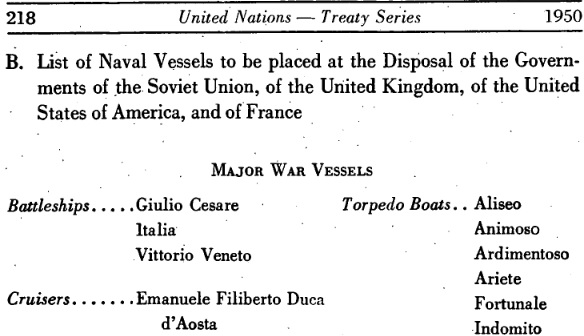 In 1948, the Four-Power Commission identified the specific battleships to be used as reparations. Italia, Vittorio Veneto, and Giulio Cesare were to be transferred to the USA, UK, and USSR.
In 1948, the Four-Power Commission identified the specific battleships to be used as reparations. Italia, Vittorio Veneto, and Giulio Cesare were to be transferred to the USA, UK, and USSR.
 The specific limitations on the postwar Italian navy, Article 59 of the Peace Of Paris, were now in effect. Italy was banned from having aircraft carriers, submarines, PT boats, ballistic missiles, amphibious assault ships, chemical or nuclear weapons, or offensive sea mines. A cap on total tonnage, and total manpower, was also put into effect. The first line of Article 59 was worded that Italy could not build, buy, or replace battleships. However Italy was not outright prohibited from keeping the two Andrea Doria class ships, but, could not replace them (postwar Italy never had any intention of building battleships anyways). The Four-Power Commission inserted this caveat in case the crew of one of the three reparations battleships scuttled it, so that there would be two ready replacements.
The specific limitations on the postwar Italian navy, Article 59 of the Peace Of Paris, were now in effect. Italy was banned from having aircraft carriers, submarines, PT boats, ballistic missiles, amphibious assault ships, chemical or nuclear weapons, or offensive sea mines. A cap on total tonnage, and total manpower, was also put into effect. The first line of Article 59 was worded that Italy could not build, buy, or replace battleships. However Italy was not outright prohibited from keeping the two Andrea Doria class ships, but, could not replace them (postwar Italy never had any intention of building battleships anyways). The Four-Power Commission inserted this caveat in case the crew of one of the three reparations battleships scuttled it, so that there would be two ready replacements.
In practice, the postwar Italian navy flagrantly ignored many of the limitations. Neither the UK nor USA (now Italian allies) cared, and there was little the Soviets could do about it. (Later, in February 1952, Italy formally stated it no longer was going to abide by the naval limits at all.)
In March 1948, the preliminary specifics of the transfer were debated. The Soviets wanted their battleship to receive a refit in Italy at Italian expense, sailed from Italy at Italian expense, then be turned over to them at Odessa, USSR; with a full surrender-type ceremony. Additionally they wanted some Italians to remain aboard to train the first Soviet crew. Obviously the Italians did not agree to all these terms, and only agreed to refurbish the ships to the point of making them safely seaworthy.
To avoid more squabbling over which country got which ships, they were selected at random. The USSR was awarded Giulio Cesare as part of the randomly-selected “Lot C”.
The USA and UK had already decided that they had no interest in taking physical possession of their prizes. They were instead donated to Italian shipbreaking companies free of charge to create jobs, with the scrap metal proceeds going to fund reconstruction of WWII-damaged cities. The US State Department timed the announcement of the free donation with the USSR’s intent to take their battleship, in the hopes that it would antagonize Italian citizens towards the Soviets.
Delivery to the USSR
In December 1948, Turkey announced it was invoking the Montreux Convention (international rules for the Bosporus connecting the Aegean Sea with the Black Sea) regarding Giulio Cesare. The Turks cleverly exploited a loophole restricting the tonnage of non-Black Sea combatants transiting the Bosporus…….since the Soviets wanted the official transfer ceremony to take place in Odessa, the battleship would still technically be Italian (a non-Black Sea nation) when it went through the straits, and thus, Turkey could restrict it’s passage. This infuriated the Soviet government but it was legal to the treaty. Most likely, Turkey was doing this to gain favor with the USA as the declaration served no purpose other than to inconvenience the USSR.
Italy refused a suggestion to sail the battleship to Odessa under the Soviet flag but with an Italian crew, on the grounds that they were not confident the sailors would be free to leave afterwards (the USSR was still holding German and Japanese POWs).
There was one last bit of drama for the ship before it changed hands. On the night of 9 December 1948, when Giulio Cesare was in Augusta, Italy, preparing for the turnover to the Soviets, some crewmen unsuccessfully tried to sabotage the battleship’s engines. This was kept hidden from the USSR, lest they reject Giulio Cesare for a more modern “replacement”.
After some final negotiations it was decided that Giulio Cesare would be handed over at the port of Vlore in Albania, by then firmly a communist country. On 9 February 1949, the Italians turned over the battleship to the Soviet navy at Vlore. The ceremony was brief and nondescript, as obviously the Italians took no joy in it and the Soviets wanted the public “commissioning” to be a grand ceremony in a Soviet port. Turkey again invoked the Montreux Convention, which stipulated that any foreign warship in the Bosporus has to have some kind of name. The USSR assigned the temporary name Z11.
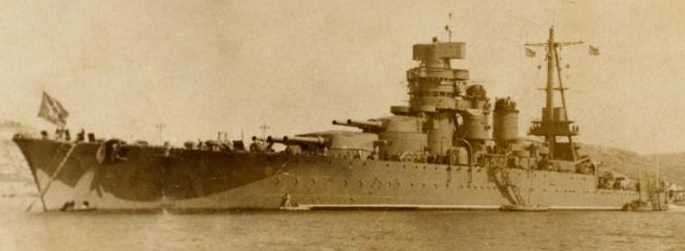 (Novorossiysk in Soviet colors.)
(Novorossiysk in Soviet colors.)
On 20 February 1949, the battleship departed Albania and sailed around Greece, up the Aegean Sea, and through the Bosporus. The voyage was no pleasure cruise, as the Soviet crew discovered the Italians had done only the absolute bare minimum maintenance before surrendering the battleship, which under the fresh paint was in terrible shape. Additionally none of the gauges, dials, etc had been translated into Russian. The first Soviet captain of the ex-Italian ship was Rear Admiral Gordey Levchenko. He had quite a curious career, having been an Admiral before WWII, then busted down to junior Captain by Stalin during the German invasion in WWII, barely avoiding the gulag. Through hard work, he again rose through the ranks back up to Rear Admiral. He was chosen for this mission due to his “political reliability” and past experiences on Soviet battleships in the Baltic Sea. His performance was excellent and quite possibly helped avert a disaster with this ship right off the bat.
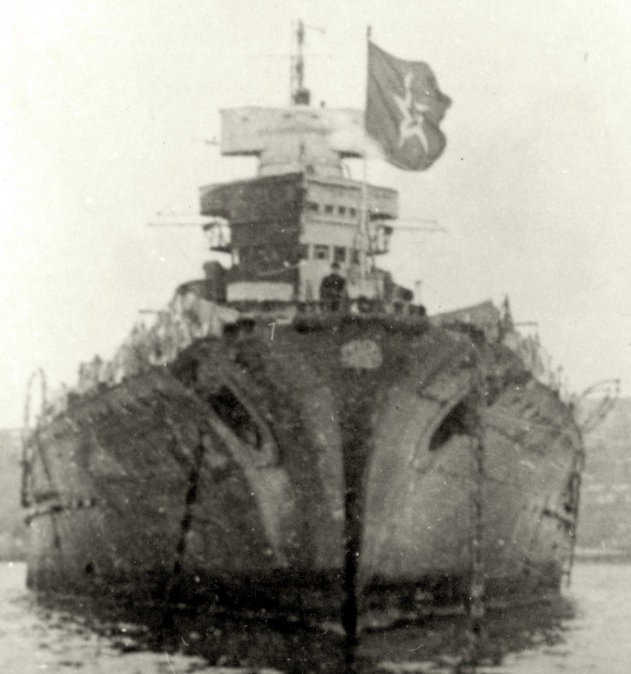 (Novorossiysk shortly after the transfer to the USSR, wearing the initial disruptive-pattern camouflage.)
(Novorossiysk shortly after the transfer to the USSR, wearing the initial disruptive-pattern camouflage.)
After a harrowing week at sea, the battleship arrived at Sevastopol, USSR. On 5 March 1949, a formal recommissioning ceremony was held and the name Novorossiysk was bestowed.
Novorossiysk in Soviet service
Novorossiysk was (in terms of displacement and gun caliber anyways) the most powerful warship in the Black Sea in 1949. Far from Novorossiysk‘s eventual training role, the Soviets had every intention at first of using the battleship as a front-line combatant. Part of this was due to Josef Stalin’s completely clueless outlook on post-WWII naval technology. Stalin envisioned his navy to be, by the 1950s, centered on all-gun battleships, battlecruisers, and medium cruisers; which would somehow engage the US Navy in World War One-type set gunnery duels. The US Navy had already long since moved on and was centered on high-performance strike planes off aircraft carriers and submarine operations. Stalin’s plans were not even in the realm of reality, but few in the USSR chose to argue with him. The CinC of the Soviet navy was Fleet Admiral Nikolay Kuznetzov, a hero of WWII who periodically fell in and out of favor with Stalin. Kuznetzov was a bit more pragmatic but was also a fan of WWII-style all-gun ships.
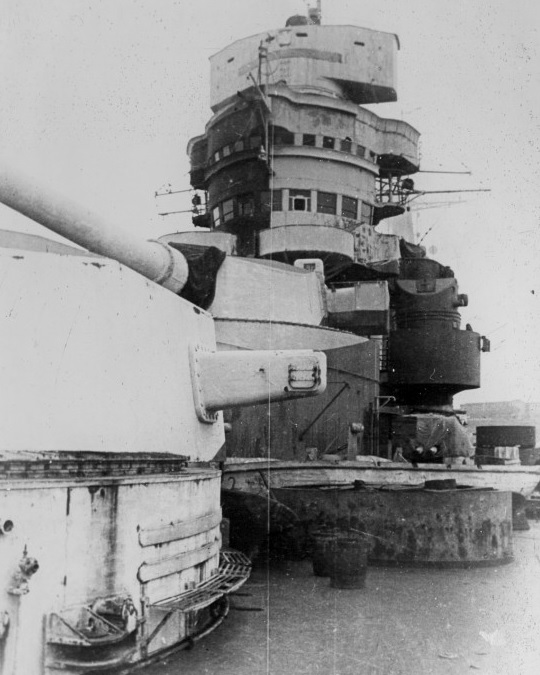 (The conning tower of Novorossiysk early in the battleship’s career with the Soviet Black Sea Fleet.)
(The conning tower of Novorossiysk early in the battleship’s career with the Soviet Black Sea Fleet.)
During the first few years, maintenance of Novorossiysk was no easy task. Because of general neglect by Italy in the half-decade inbetween the armistice and the transfer, many electrical components grounded out and some infrequently-used internal fittings rusted shut. As no spare parts were included from Italy, anything broken had to be reverse-engineered from scratch or somehow substituted with a Soviet navy part. There was a mold problem aboard, and externally the shaft struts and rudder needed major cleaning. One particular annoyance was that during WWII, it was Italian navy practice to only serve simple rations underway and have the crew use ashore mess halls inport. In the Soviet navy, the crew always dined aboard and the tiny galley was totally insufficient to feed the men. Some WWII-vintage Soviet army field kitchen gear was shoehorned into the galley but it was a continuing challenge to feed the crew.
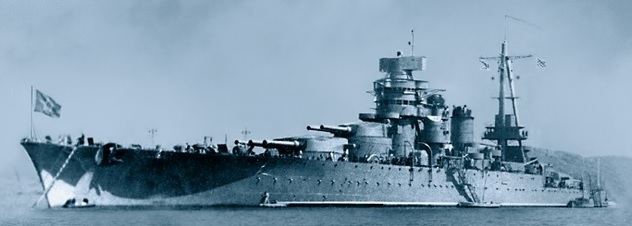 By the start of 1950, it was becoming apparent that using Novorossiysk in a front-line role was optimistic at best. The Soviet Black Sea Fleet had an acute shortage of Italian linguists, and many operational manuals had to be made up “on the fly”. By now the steam turbines (still from the 1937 conversion) were starting to show their age.
By the start of 1950, it was becoming apparent that using Novorossiysk in a front-line role was optimistic at best. The Soviet Black Sea Fleet had an acute shortage of Italian linguists, and many operational manuals had to be made up “on the fly”. By now the steam turbines (still from the 1937 conversion) were starting to show their age.
The Italians were only required to deliver as much ammunition as the battleship could carry in a normal condition, and they did not provide a single round above the minimum requirement. In 1950, as the final act of military reparations, an entire shipload of WWII ammunition was delivered by Italy. However this included all types of ammunition and it’s unknown how many 12″ battleship rounds were included, if any. The Soviets had to reverse-engineer both the shell and propellant bag designs and manufacture them at significant expense. The reverse-engineered ammunition was of lesser quality but good enough for basic gunnery drills.
None the less, in 1950 Novorossiysk did in fact join an operational squadron of the Soviet Black Sea Fleet, and made a foray to the southern side of the Black Sea, with the goal of provoking some sort of response from NATO. Novorossiysk was thus (for a while anyways) listed as the largest Soviet combatant by NATO. Thereafter Novorossiysk gradually transitioned to a training ship, being used for gunnery drills and basic seamanship training; as well as an OPFOR vessel during wargames.
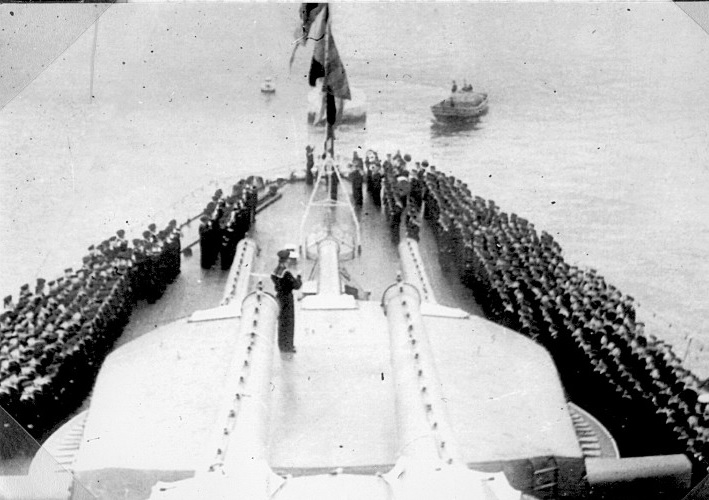 (Crew muster and morning colors aboard Novorossiysk during it’s service as a training ship.)
(Crew muster and morning colors aboard Novorossiysk during it’s service as a training ship.)
Between May 1949 transfer and March 1955, Novorossiysk had eight refits in six years, an absolutely incredible amount of shipyard time and money spent on a WWII-vintage vessel of limited use. The first refits installed Soviet radios and repaired equipment broken at the time of the transfer. One of the subsequent refits replaced the Yarrow geared steam turbines with Kharkov models. This engine swap was very expensive and no other navy would have probably done it, had it not been for fear of Stalin.
The final refit stripped off all the Italian 100mm, 37mm, 20mm, and machine guns. In their place, Soviet AA guns were fitted: eight 70K twin 37mm and a dozen 84KM 25mm weapons. A Soviet radar was installed on a new mast, and current Soviet IFF gear was fitted. Additional training systems were also installed, and more internal plumbing was added. Due to the increased electrical demands Soviet-made diesel generators were fitted.
After the last refit, Sevmorzavod shipyard cautioned that Novorossiysk was overloaded 130 tons past maximum displacement and the centre-of-gravity was now very slightly (about 4″) shifted above it’s safe limit. The Soviet navy was not concerned as it was unlikely that Novorossiysk would ever actually be used in a battle by then.
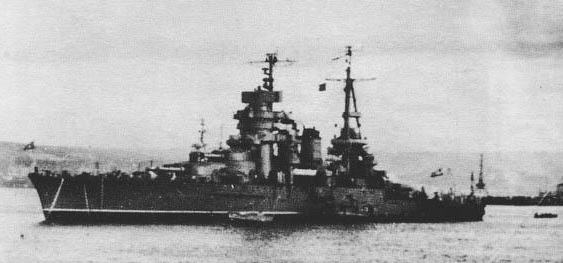 (Novorossiysk after the last refit, with Soviet radars and AA guns fitted.)
(Novorossiysk after the last refit, with Soviet radars and AA guns fitted.)
Prior to the sinking, the Soviets still had further plans for Novorossiysk. It was planned to replace the Italian 12″ guns with Soviet-made SM-33 12″ weapons. This gun had been designed for the Stalingrad class battlecruiser program, an insane pet project of Stalin’s which sought to construct enormously expensive all-gun WWII-style battlecruisers in the 1950s. The Stalingrad class project had already died shortly after Stalin himself in March 1953, but the SM-33 design was well along and the Soviets wanted to get some use out of their investment.
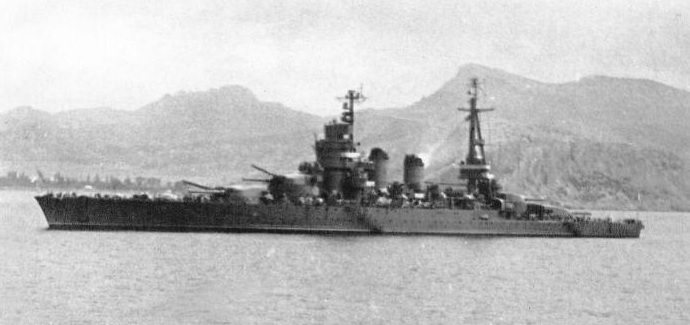 (This is possibly the last photo taken of Novorossiysk before the battleship sank.)
(This is possibly the last photo taken of Novorossiysk before the battleship sank.)
THE LOSS OF NOVOROSSIYSK
On the afternoon of 28 October 1955, Novorossiysk returned to Sevastopol from a gunnery drill in the Black Sea. The battleship anchored at Sevastopol’s #3 mooring buoy, adjacent to the Soviet Naval Hospital, about 1,000′ off the beach. The water at the mooring buoy is about 60′ deep. There were 1,542 sailors aboard; far more than the intended WWII complement but not uncommon for a warship being used for training.
The captain of Novorossiysk departed ashore, leaving the executive officer in command. After the evening meal, about 240 of Novorossiysk‘s core crew departed for shore leave. At the same time, 200 cadets came aboard for the next planned drills, along with several dozen (the total is disputed) naval infantry soldiers and shipyard mechanics. In all, there were about 1,530 people aboard Novorossiysk.
At 01:31 on 29 October 1955, a massive explosion occurred directly underneath the starboard bow. The explosion, estimated by the Soviets to be equivalent to 2,648 lbs of TNT, blew a huge hole in the battleship’s belly 1,614 ft² in area, in an irregular shape 68′ long by 12′ wide. The explosion was so powerful that some of Novorossiysk‘s hull plates folded inwards as much as 9’. At the core of the hole, the blast traveled upwards penetrating every internal deck up to the weather deck. It was estimated by the Soviets that the entire bow area of the ship momentarily bent 5º upwards from the rest of the vessel. All starboard longitudinal frames in the forward 66′ section of Novorossiysk were severed, and several transverse bulkheads warped, in some cases so badly that watertight doors did not dog shut. Immediately, the inrush of seawater caused Novorossiysk to heave down on the bow, taking a -3º trim, and a 1º list towards starboard.
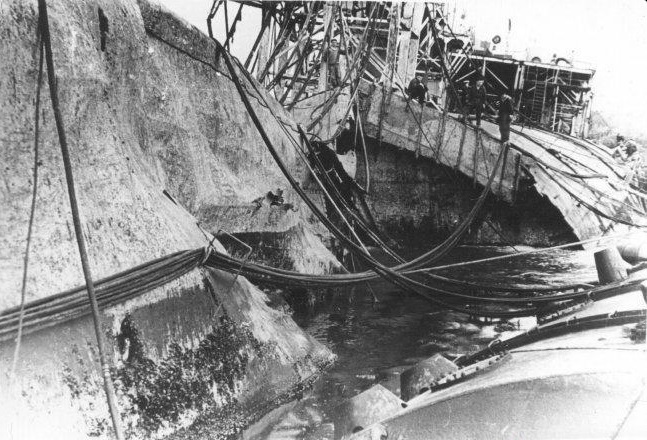 (The damaged starboard section of Novorossiysk. This photo was taken after the wreck had been refloated but was still capsized. The structures and scaffolding were related to the salvage effort.)
(The damaged starboard section of Novorossiysk. This photo was taken after the wreck had been refloated but was still capsized. The structures and scaffolding were related to the salvage effort.)
(Another photo taken at the same time as above; this shows the port side of the capsized Novorossiysk which was opposite the blast. The hull is caved in both from the initial blast on the starboard side and the internal bulkheads failing.)
Obviously people at Sevastopol naval base were awakened and nine minutes after the blast, at 01:40, the commander of the base began to organize a response. At 02:00, twenty-nine minutes after the blast, the starboard list had increased a bit to 1 ½º and the Black Sea Fleet’s operations officer ordered any available tugboats to begin pushing Novorossiysk closer to shore, but not aground. The WWII-era battleship lacked a modern anchor shear and the chains had to be manually torched, slowing this process. At the same time, the CinC of the whole Black Sea Fleet, Vice-Admiral V.A. Pakhomenko, arrived at the scene to take charge. He was quickly joined by the commander of Soviet cruisers, a ship squadron commander, the senior commissar in the Black Sea, and about two dozen other high-ranking officers including several admirals. This concentration of authority had opposite the intended effect as the chain of command was now confusing and diluted.
At 02:32, one hour after the blast, the bow trim had increased to -5º and the starboard list had increased to 3º. By this time Novorossiysk had been towed to a point about 660′ from shore, with the battleship’s stern pointing towards land. The water depth at that spot was 56′ (only 22′ more than the ship’s draught) however, critically, the seafloor was very loose mud and silt, almost an underwater quicksand. Vice-Admiral Pakhomenko did not fully understand the seriousness of the situation, as it was (accurately) reported that the list was only increasing about a degree per hour.
Other Soviet warships moored at Sevastopol were now dispatching their lifeboats towards Novorossiysk. A civilian ship came alongside with a searchlight to assist the damage control teams. While this was happening, the internal communication phones aboard Novorossiysk shorted out as some were now underwater.
At 03:25, lifeboats of other warships began removing some men off Novorossiysk. Admiral N.I. Nikolskiy, the commander of the squadron Novorossiysk belonged to, requested that everybody not directly stopping the flooding be evacuated. Vice-Admiral Pakhomenko refused, as he felt the situation was at best already under control, and at worst, the battleship would slowly sink upright (much like the American battleships at Pearl Harbor in WWII). With the shallow water depth, the turrets, upper deck, and conning tower would all still be above the waterline allowing an orderly evacuation if needed. By 03:31, two hours after the blast, there were more than 800 sailors (including almost all of the cadets who had just come aboard several hours before) standing on the weather deck, not doing anything other than getting in the way.
Events now began to rapidly change. The starboard list, which had only been 5° when Admiral Nikolskiy made his first request at 03:25, was 9° by 03:39. Thus the initial rate increase of +2° per hour had now picked up to +2° every 15 minutes. Nikolskiy again requested to have all non-essential sailors evacuated, and was again reused by Pakhomenko, who was being told by the ship’s XO that the situation was under control. There is a long-standing sea story in the Russian navy that the XO insisted a traditional overnight tea service go on as scheduled; it’s unknown if this is true, but in any case some senior officers aboard Novorossiysk were being grossly over-optimistic. Pakhomenko did agree to have the tugboats which had moved Novorossiysk re-tie to the ship’s port side, in an effort to pull the hull opposite the list.
At 03:50, about two and a half hours after the blast, the bow was now trimmed down -4º and the starboard list had increased to 11°, now increasing a degree every five minutes. (It was probably accelerating even more, but being masked by the tubgoat MB-30 which was pulling the opposite direction with all it’s might.) Clearly Novorossiysk was in serious trouble. At 03:55 the list was 12º and one of the senior officers cautioned that the Conte di Cavour hull design had a lateral movement limit of ±18 ¾° and at ±20° list the ship would likely capsize. Still, no abandon ship order was given.
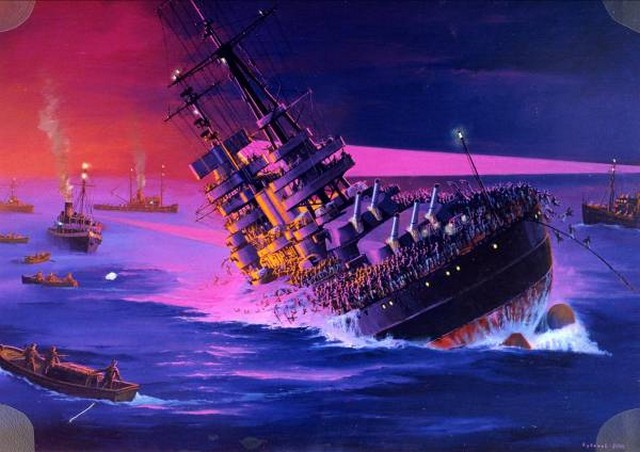 At 04:00, the list was 17° and still increasing. By now, some sailors started to jump overboard without permission, while about 800 more congregated on the weather deck’s starboard side, which human instinct would lead to believe to be safer opposite the list. About 350 more sailors were still below decks.
At 04:00, the list was 17° and still increasing. By now, some sailors started to jump overboard without permission, while about 800 more congregated on the weather deck’s starboard side, which human instinct would lead to believe to be safer opposite the list. About 350 more sailors were still below decks.
At 04:09, Novorossiysk passed the 18° stability limit, having now taken on 7,000 tons of seawater. At 04:14, two hours and forty-three minutes after the explosion, Novorossiysk listed 21° to starboard and suddenly lurched down a bit, then briefly rolled to starboard, then sharply snapped to the port side and capsized in that direction. Survivors described the sensation as liquid being sloshed in a half-full jug; it’s thought that the unusual effect was caused by the highly asymmetric flooding. While the water depth was shallow, the muddy seafloor failed to stop the ship and it rolled about 80% over. It slowly continued to settle into the ooze and by that afternoon was fully submerged.
Tragedy
A total of 609 Soviet sailors died. A hundred men died immediately from the blast. Four hundred and forty-six men from the ship died during the capsizing. Fifty-eight damage controlmen from nearby ships and five men from an ashore specialist salvage team at Sevastopol base also died during the capsizing. Another forty-eight sailors were seriously injured during the capsizing. It was the worst peacetime catastrophe in the Soviet navy’s history.
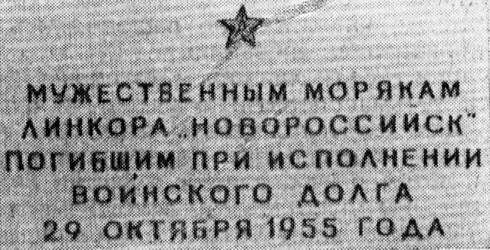 (Monument plaque to the sailors lost aboard Novorossiysk.)
(Monument plaque to the sailors lost aboard Novorossiysk.)
Obviously drowning was the main cause of death. However many men had blunt-force trauma. During the many refits, equipment had been added and removed ad hoc, and in an increasingly sloppy manner as the years passed and Novorossiysk became a training vessel. As the battleship rolled over on it’s port side, the 800 men on the weather deck were struck by falling gear lockers, antennas, stanchions, etc; which had been lazily installed on the assumption the ship would spend the rest of her days drilling in calm seas. The situation was compounded by so many men being huddled together on the port side. Likewise below decks, damage control teams were struck by unstowed items falling off shelves and out of unlatched lockers.
Only nine people were rescued from the overturned hull after the sinking. In the few hours before Novorossiysk completely submerged, a team cut through a known weak spot near the stern (below photo) and pulled seven sailors to safety.
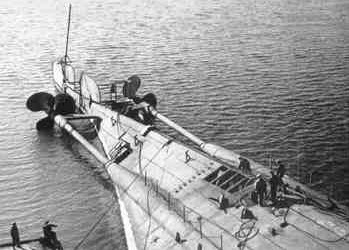 Once the ship was fully underwater, scuba divers managed to swim inside it and led two sailors trapped in an air pocket to safety. Further efforts were hampered by the silt thrown up, making underwater visibility near zero. For two days afterwards, rescuers heard tapping from the submerged hull but were unable to rescue any more men.
Once the ship was fully underwater, scuba divers managed to swim inside it and led two sailors trapped in an air pocket to safety. Further efforts were hampered by the silt thrown up, making underwater visibility near zero. For two days afterwards, rescuers heard tapping from the submerged hull but were unable to rescue any more men.
Public reaction
The government initially tried to suppress news of the disaster. However in this case, it was obviously impossible to hide many hundreds of simultaneous deaths, and in any case, an untold number of people at Sevastopol naval base had also seen the huge battleship sink. Word spread first through WWII veterans clubs, and then in the general public.
Unusually in the USSR, editors of mouthpiece communist newspapers were bombarded with angry letters from ordinary citizens, furious at the navy for allowing a battleship to sink at anchor in it’s homeport.
Naval effects
Novorossiysk itself was a worthless WWII relic, but included in the dead were expert gunnery instructors, drill monitors, and newly-trained crewmen who were supposed to fill hundreds of empty positions in the Soviet navy. Also lost was the specialist heavy-hull salvage team from Sevastopol navy base. The wreck of Novorossiysk still had live ammunition onboard, and was now just a few hundred feet away from the base’s buildings and other warships.
NATO intelligence was already aware of the sinking the next day, and word was leaked (probably intentionally, to embarrass the Soviets) to the New York Times newspaper.
Political fallout
Josef Stalin’s successor in 1953, Nikita Khrushchev, shared absolutely nothing of Stalin’s big-gun big-ship naval outlook. His vision of the future navy was centered around long-range submarines, missiles, and inshore strike vessels. He had very little patience with the navy’s aging leaders, who he called “dead wood”. Predictably, a house-cleaning followed the disaster.
The CO of Novorossiysk, Cdr. Kukhta (who was not even aboard when the explosion happened) was relieved under the principle of command responsibility. Novorossiysk‘s XO, Cpt. Khurshudov (who was the acting captain in Kukhta’s absence) was also relieved, due to his unwarranted optimism throughout the ordeal. Bizarrely, Kukhta was transferred to the naval reserve but Khurshudov wasn’t. The CinC of the Black Sea Fleet, VAdm. Pakhomenko was found directly responsible but unbelievably, the squadron commander Adm. Nikolskiy (who tried to correct Pakhomenko and save the crew throughout the incident) was also equally blamed. There were other demotions and reprimands, some of them almost certainly “score-settling” in the petty and politicized Soviet navy – for example, a commissar at Sevastopol naval base who couldn’t have possibly had anything to do with the incident.
Nobody was court-martialed and later some demotions were reversed without explanation.
The biggest political after-effect was the replacement of the commander of the entire Soviet navy, Adm. Kuznetzov. Khrushchev viewed Kuznetzov as a stale unwanted legacy of Stalin’s big-gun plans, and the admiral also often quarreled with the army’s commander Gen.Georgy Zhukov, whom Krushchev favored. The Novorossiysk disaster was a perfect opportunity for Krushchev to get rid of the WWII hero, as the public was furious at the navy in general. Kuznetzov was replaced by Adm. Sergey Gorshkov, father of the modern Russian navy. In public, it was announced that Kuznetzov was retiring.
The wreck itself
On 1 November 1955, the overturned Novorossiysk laid about 6′ below the water surface inside Sevastopol naval station. The harbor rarely, but occasionally, ices over in December and January so it was decided to wait until spring to do anything. In March 1956, operation “EON-35”, salvage of the Novorossiysk, began. At it’s peak, “EON-35” involved 700 officers and enlisted sailors. Included were some survivors of the sinking, as they knew the layout of the ship. By late April, the Soviet navy was ready to proceed.
The first step was to use sluice mining equipment to burrow tunnels in the mud under the capsized Novorossiysk so that cables could be run around the hull. A floating pipeline was laid for the sluice job.
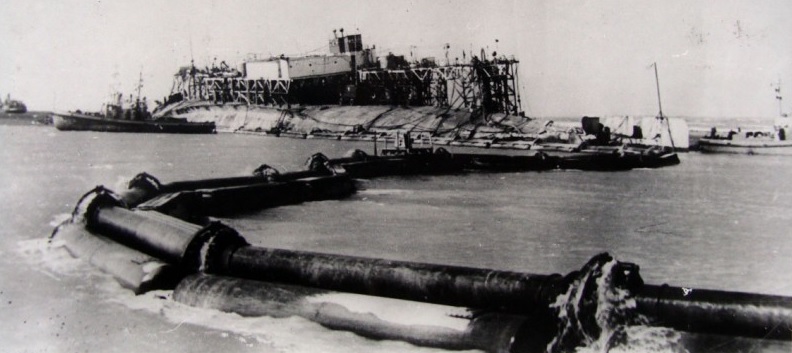 (Remains of the floating sluice pipeline, later reused for the dewatering after Novorossiysk had been raised.)
(Remains of the floating sluice pipeline, later reused for the dewatering after Novorossiysk had been raised.)
Next, 250 holes were drilled into the hull, and about an equal number of openings (including the blast area) were either welded shut or patched with underwater concrete. The holes were to be used to blow compressed air in, and for water to be forced out of, the hull in a controlled manner. The date for refloating the ship was set for 4 May 1946. The “EON-35” team had been sworn to secrecy but obviously was not adhering to such, as hundreds of Sevastopol residents were waiting to watch the event from hillsides around the base.
On the morning of 4 May, pontoons were attached to the cables slung under the ship and the blowing began.
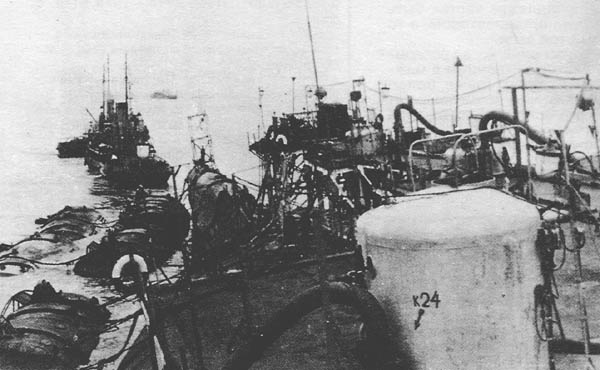 (Novorossiysk being refloated via compressed air on 4 May 1955.)
(Novorossiysk being refloated via compressed air on 4 May 1955.)
A total of 24 large compressors were needed. The refloating took four hours and was successful. It was not attempted to right the hull, as the Soviets estimated there was 96 tons of large-caliber and 4 tons of AA ammunition onboard. Instead, the refloated wreck was almost immediately towed to Cossack Bay, an area further away from the base and city.
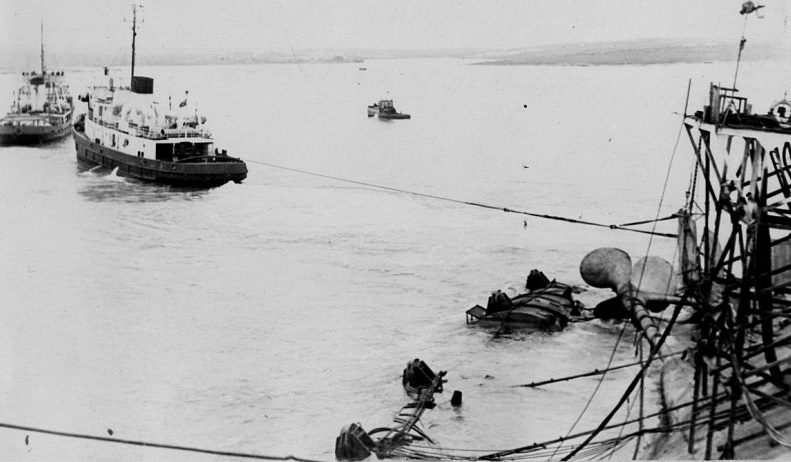 (The raised wreck being moved.)
(The raised wreck being moved.)
A prefabricated structure was set atop the overturned ship’s underside. This provided the “EON-35” team with power, water, and shelter during rain.
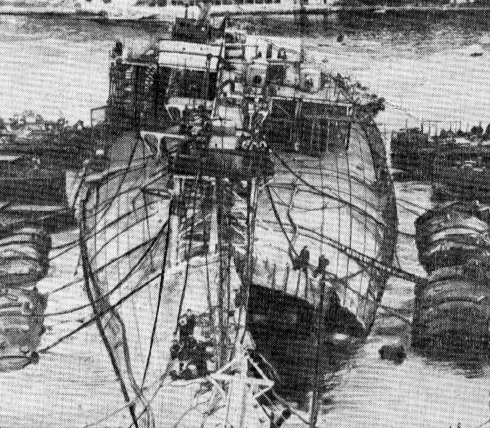 (The shelter being set in place. The size of the area damaged by the explosion is evident.)
(The shelter being set in place. The size of the area damaged by the explosion is evident.)
The absolute top priority was getting the live ammunition off the wreck. The “EON-35” team carefully cut away chunks of hull over the bottoms of the ammunition magazines and the recovery was handled without incident.
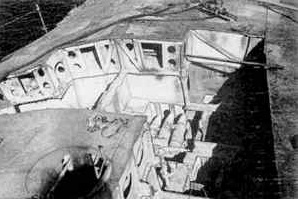 (Ammunition from the main guns being offloaded in 1956.)
(Ammunition from the main guns being offloaded in 1956.)
Afterwards the rest of the wreck was slowly cut up and sent to the Zaporizhstal steel mill for scrapping.
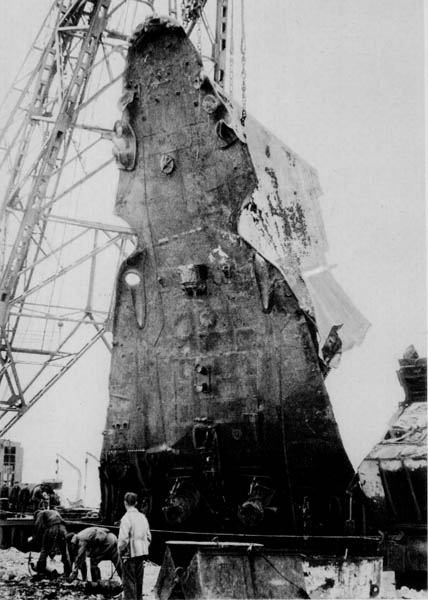 (Above two photos: The final scrapping of Novorossiysk.)
(Above two photos: The final scrapping of Novorossiysk.)
The “X” (upper aft twin) main turret fell off the ship when it was refloated. It had to be separately dead-lifted out of the water upside-down as it was not naturally buoyant.
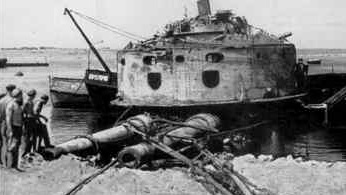 The main guns (the actual breech and barrel assemblies) were cleaned and found to be undamaged. They were retained for possible use as ashore coastal artillery. Perhaps due to the human tragedy this was never done and they were scrapped without comment in 1977.
The main guns (the actual breech and barrel assemblies) were cleaned and found to be undamaged. They were retained for possible use as ashore coastal artillery. Perhaps due to the human tragedy this was never done and they were scrapped without comment in 1977.
Possible causes for the disaster
The Soviet inquiry was led by Gen. Vyacheslav Malyshev, a renown engineering genius who had a keen ability to understand complex blueprints. He was also a bold, “no-nonsense” man, and one of the few Soviets willing to challenge Josef Stalin while he was still in power. Malyshev had been one of the first Soviet experts to tour Novorossiysk in the 1940s when it was still Giulio Cesare, and voiced disagreement with Stalin’s plan to take the ship. Malyshev said the vessel was both useless and unsafe. Stalin ignored his criticism but took no action against him, out of respect for his knowledge.
Almost immediately in 1955, Malyshev knew the explosion was not internal. Nothing explosive was stored in the area of the blast. The nearest area with munitions was the powder magazine of the “A” main turret. Some of the capsizing survivors had been in that area, and reported not only had there been no explosion there but the magazine was still undamaged when they eventually fled the compartment.
When the wreck was raised and could be inspected, Malyshev knew for certain the explosion was external. The damage pattern resembled an upwards-rising column; if it had been inside the ship it would have been spherical expanding in all directions. Furthermore the underside hull plates were bent inwards.
♦Leftover WWII mine
This was the eventual determined cause, not because of any strong evidence but because any other theory lacked real credibility. Sevastopol harbor was heavily mined by the Germans during WWII. The Black Sea naval mine clearance effort ran from 1945 until 1951. Because of lingering concerns, Sevastopol harbor was swept again in 1953.
The inquiry determined that the explosion originated on or near the seabed, due to a large crater found when Novorossiysk was refloated. One of the mines Germany used in WWII, the Type RMH, was a difficult to sweep (wooden-body) seafloor magnetic fuze mine with a warhead of 1,698 lbs (approximately 2,000 lbs TNT equivalent) which more or less matched the 2,648 lbs force the Soviets estimated the blast at. The Type RMH was laid heavily in the Black Sea and many were swept in Sevastopol after WWII.
There are several problems with the RMH theory, which require understanding of magnetic fuze mines. The RMH’s fuze is basically a tiny rod inside a coil. When a magnetic field (the hull of a ship) passes overhead, induction in the coil moves the rod down onto a striker, which activates the fuze, detonating the warhead.
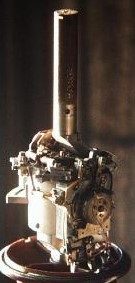 (WWII German magnetic sea mine fuze. The large cylinder is a field amplifier; the actual coil-and-pin assembly is in the housing below.)
(WWII German magnetic sea mine fuze. The large cylinder is a field amplifier; the actual coil-and-pin assembly is in the housing below.)
The Type RMH mine remained viable for an average of seven years, and an absolute maximum of nine years. The Novorossiysk blast happened over ten years after the end of WWII. It is possible that somehow there was an outlier beyond the extreme end of the mine’s lifespan, but very unlikely. In any event, it is irrelevant. Mooring buoy #3, where Novorossiysk was at, had been used 135 separate times between 1945-1953, including several times by Novorossiysk itself. If the fuze was somehow still active, it would have had almost certainly detonated already. The RMH’s fuze could be set for immediate or 6-hour delay detonation, but Novorossiysk had been moored for about 9 hours. The inquiry did not have an explanation for either issue.
An alternate theory involves a very rare phenomenon of nature, where saltwater of changing temperature flowing around a stationary ferrous object induces a very tiny static charge. In theory this could have, perhaps, moved the pin inside the coil just enough to touch the striker, detonating the mine which happened to be directly underneath a mooring buoy. This would be a very exceptional chain of occurrences and was not repeatable in tests.
There was one other possibility determined. While the inquiry’s whole report was secret, there was an unredacted “extra” version expressly for the highest levels of Soviet government not known in the west until the 1990s. It mentioned the Soviet-made AMD-1-1000 seafloor mine, which was used in the last part of WWII and then heavily manufactured during the early part of the Cold War. It had a 1,543 lbs warhead and a fuze basically similar to the style described above.
It is possible that an AMD-1-1000 was somehow accidentally dropped at the #3 anchorage, and then not reported by the negligent ship or plane. This is unlikely as the mine weighs over a ton and would make a splash noticeable around the area, and in any case it would need to have been dropped either with the safety off (in which case, the next metal object would have detonated it), or, have been somehow dropped in a way which damaged the safety but not the casing, fuze, or warhead; which is extremely unlikely.
After the Novorossiysk sinking, Sevastopol harbor was thoroughly re-swept again. Nineteen WWII mines were found, three within 50 yards of where Novorossiysk had been moored.
♦Sabotage
As was typical in the USSR, this was initially the favored theory. It was quickly discounted by the inquiry. As the explosion happened external to Novorossiysk, it was impossible for the crew to have caused it. An outside party would have needed to somehow covertly planted over a half-ton of explosives in a highly-visible area, in a precise underwater location, with some type of advanced fuze; all to sink an irrelevant WWII relic.
While the theory was quickly eliminated, one disturbing thing was discovered. Some of the original Italian propellant bags for the main guns still existed. The crew regarded the aging Italian-made gunpowder as dangerous and tried to avoid using it, preferring the Soviet copy bags and keeping the Italian bags ashore in a bunker. The inquiry recommended destroying the remaining Italian-made ammunition, some of which was now more than 20 years old.
♦Foreign action
This was the most exotic theory examined by the inquiry. Today, it is the most frequently discussed by “armchair historians”. The Italian navy has an elite frogman team, COMSUBIN, which is a direct successor of the legendary Decima Flottiglia X of WWII. Both incarnations trained in the use of limpet mines to sink anchored warships. Some people did (and a few still do) suspect that the sinking of Novorossiysk was Italian retaliation for having to hand the ship over to the USSR. Typically the theory centers on Junio Valerio Borghese, a WWII Italian officer in Decima Flottiglia X who planned the amazing 1941 limpet mine attack which seriously damaged two moored British battleships in Egypt. After WWII he became a politician known as the “frog prince” due to his wartime exploits, and when Giulio Cesare was handed over to the USSR, he made a public statement swearing vengeance against the Soviet navy.
To begin with, any commando operation against Sevastopol in 1955 would have required (at a minimum) crossing the entire Black Sea and then penetrating several layers of Soviet observation, planting an extremely large weapon, then, escaping again undetected after the attack. This would have been the most remarkable commando operation of all time. From a more common sense perspective, it is beyond the realm of reality that Italy would have risked war with a nuclear superpower for a bit of sentimental satisfaction, by sinking a worthless relic most Italians had already long since forgotten about.
During the Cold War, there was a widely-circulated story that a rash of “secret” medals were awarded to COMSUBIN frogmen in late 1955. While Italy never discloses much about COMSUBIN, a more detailed analysis shows that a few awards (for undisclosed reasons) were issued that year, but not in any unusual pattern or large number. It appears the story gained the status of “fact” by being repeated over and over through the years. Italy repeatedly said it had nothing to do with the Novorossiysk and the USSR never accused them.
While the inquiry could not definitively rule it out, no evidence of any type of any foreign involvement was found. However the inquiry discovered shocking security lapses all over the Sevastopol base. Most notably, the expensive anti-frogman hydrophone system was found to be an unreliable failure, and was not working at all the night of the sinking.
Inquiry’s conclusion
The inquiry concluded that a WWII mine was the most likely cause, and the Soviet government accepted this. The inquiry also concluded that after the explosion, shoving Novorossiysk aground (instead of only towing it to slightly shallower water) would have destroyed the battleship but saved all the crew. Alternatively, both ship and crew might have possibly, but not certainly, been saved if more salvage vessels and pontoons were immediately brought to Novorossiysk instead of trying to move the battleship at all. In any other circumstances, the fate of Novorossiysk was sealed. The inquiry faulted the navy for not giving an abandon ship order when it was clear damage control was not even slowing, let alone reversing, the starboard list.
General Malyshev concluded that the overloading during the refits did not doom the ship but left the crew with absolutely zero safety margin. Malyshev also called on the navy to examine it’s need to still operate WWII Italian trophies a decade past the war’s end.
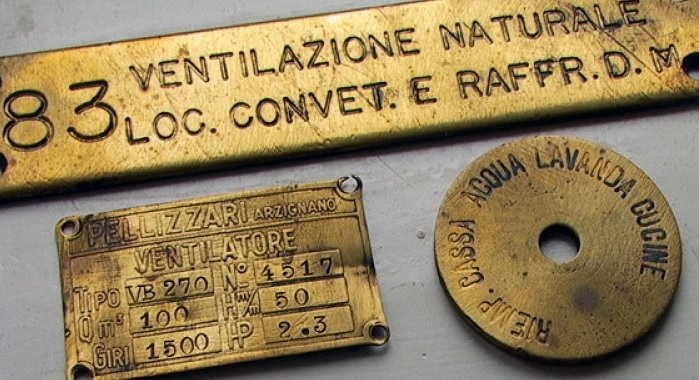 (Even at the time of Novorossiysk’s sinking, still not everything on the ship had been translated. These brass plates recovered during the scrapping identified a specific ventilation duct router.)
(Even at the time of Novorossiysk’s sinking, still not everything on the ship had been translated. These brass plates recovered during the scrapping identified a specific ventilation duct router.)
The new Soviet navy commander, Admiral Gorshkov, ordered the decommissioning of all remaining Italian war prizes (two obsolete submarines and some small ships). He also decommissioned the last two Soviet battleships.
Postscript
The true cause of the Novorossiysk disaster will, in all likelihood, never be known.
In 1996, the Russian Federation examined the case again, and was unable to find any new facts. However it was found that there were 719 award citations filed including 64 Orders Of Lenin medals (most posthumous). The Soviet navy either intentionally or through carelessness, had never approved nor denied any of the citations. The then-president of Russia, Boris Yeltsin, retroactively awarded Russia’s Orden Muzhestva medal to all involved as neither the USSR nor it’s medals existed any longer.
(A balsa model of Novorossiysk presented to the wardroom in the early 1950s, and in 1957 when it was recovered by the scrapyard.)

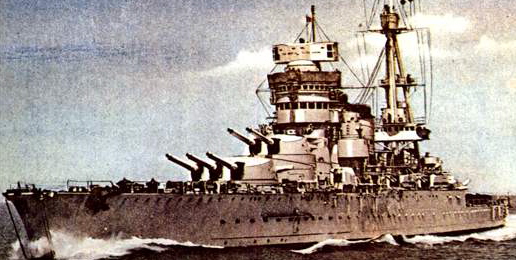
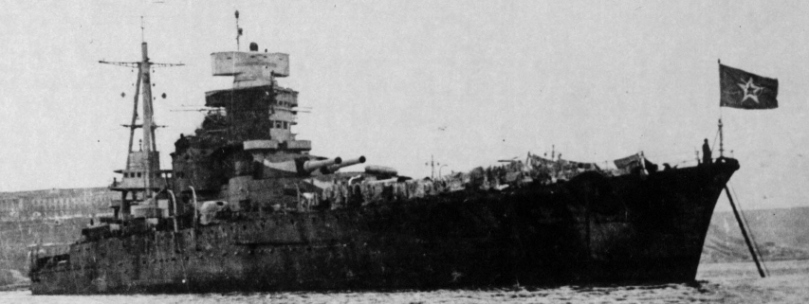
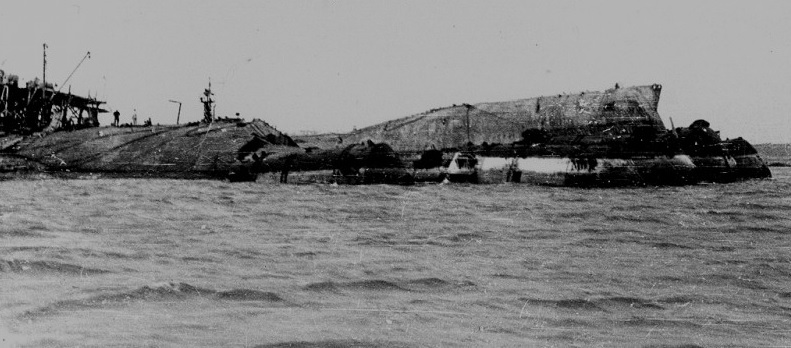
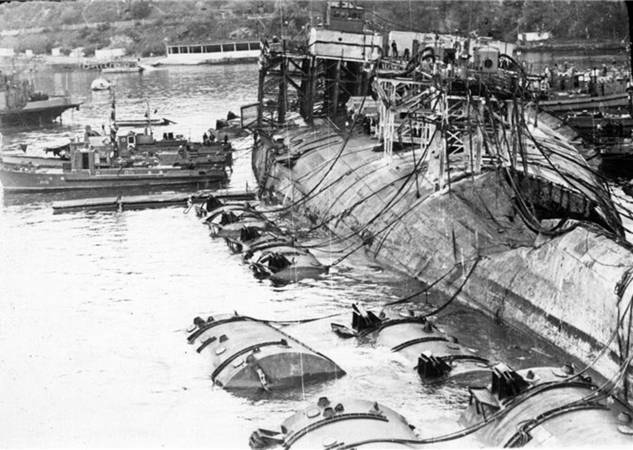
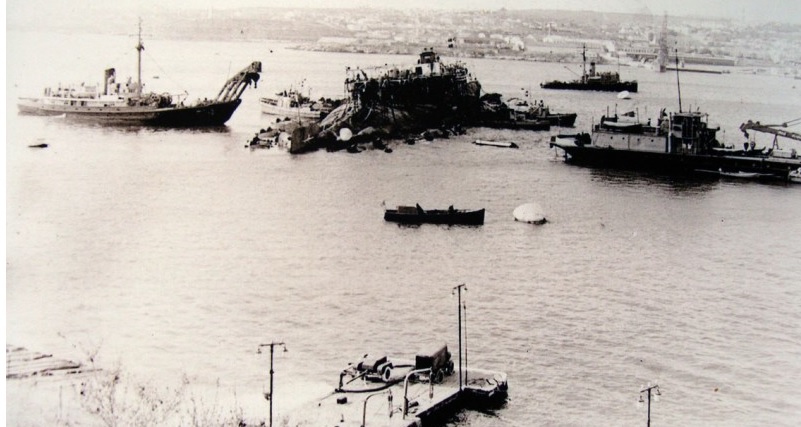
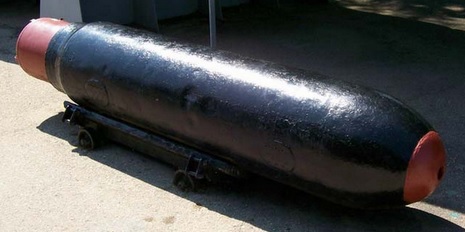
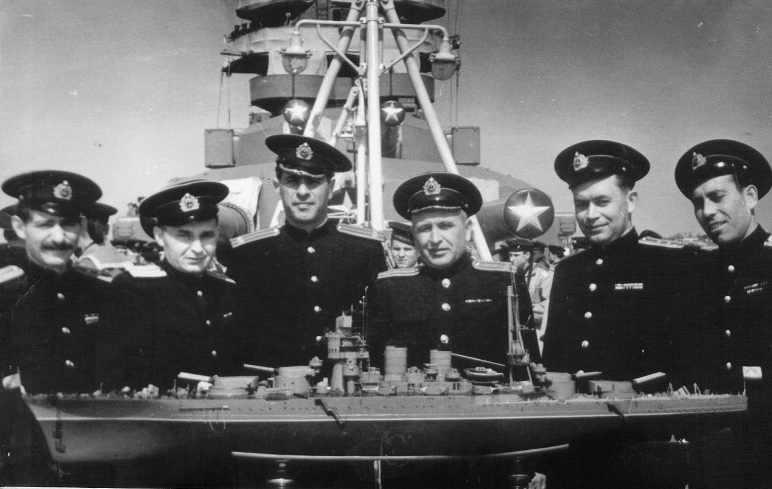

Reblogged this on Brittius.
LikeLiked by 1 person
Very interesting i have also read that they used Death charges to clear the harbour this could be important information as a death charge near a sea mine could have been the problem? The ships anchor chain could have hit the death charge then the detonation could have set of the mine increasing the blast to near the estimation of 2,648 lbs force??? as i also read the there were 2 blast holes on the sea bed under the ship and that is would have been very unlikely that the mechanism of the magnet mine would have activated after so long on the seabed
Rest in peace AYE GC
LikeLiked by 1 person
Yes I read that too, I think “depth charges” is a technically incorrect translation of countermining charges from Russian to English. On actual depth charges, the fuse is depth-oriented so being struck by a chain wouldn’t matter. I did read another theory that the chain could have acted like a big induction coil and generated a faint electrical current though.
LikeLike
I have a World Aeronautical Map from 1951 with a handwritten flight path to a spot a russian battleship was to be anchoring showing the area of sunking. Like a planned sinking. US Air Force Map.
LikeLike
[…] My 18 years old father escaped death that day. For several days after the divers were trying to rescue the trapped sailors from the areas of the overturned ship with air pockets. The visibility under water was close to zero due to the disturbed sediment from the bottom of the peninsula. Very few people were saved that way, and there were some anecdotal evidence that a diver or two had to be placed into a psychiatric care after so many days of unsuccessful attempts to save people, while they heard the knocking from the trapped sailors. Their nervous system simply gave out. If you are a history buff and would like to read more on the disaster, this blogger did a great job and you can read more about it here . […]
LikeLiked by 1 person
https://novorossijsk.wordpress.com/
LikeLike
After a long research (1 year and a half), I found the complete list of the officers of the Novorossiysk. It’s time to make it public, so that it is possible to know the names of all the brave heroes of the battleship and honor them.
If you want, I’ll publish it here in a comment, so you can add it to the text.
LikeLiked by 1 person
[…] Taranto. It was steaming in line ahead with the battleship Andrea Doria in front and the battleship Giulio [Cesare] behind it: other ships were following. All were flying the Italian flag and a black flag to denote […]
LikeLike
My father (Anatolie Nica) was on that ship, he had to sign a confidential agreement, he never spoke about that night. He had a scar on his forehead and I kept asking him where it was coming from? He always used to say it is a military secret. I thought he was joking, now I know that he wasn’t. When in late 90’s an article was published in the newspapers about Novorossiysk, I was working in Businessbank in Chisinau city, I remember I said to my colleagues that my father was on that ship and the head of the bank security (russian, former kgb agent, Alexander Maclovich) freaked out because I spoke out about it and shouted at me “It means I know your father, only 3 Moldovans survived from that ship and that means I know him, because we always watched them, and he shouldn’t have told you about that!”. I said that it is in newspapers now, everybody is taking about it. I would like to hear anything about what my father might have experienced that night on that ship, he never had the courage to speak about what happened. He passed away on the 5th October 2011, and I miss him so much….
LikeLiked by 1 person
just a quick note on the “Italian Frogmen” theory: yeah, crossing the Black Sea would have been really hard….but let’s not forget that the 101° Squadriglia MAS, a subformation of the Decima MAS (of which many men had later joined COMSUBIN), had in Sevastopol its base, so it was not as “foreign” as it would have appeared. Coincidentally, few days before the disaster, the Italian steamer Acilia (a merchant ship carrying metal scraps) had docked in Sevastopol leaving from Brindisi (which was and is a major Navy base in Italy), so…take what you will, but it wouldn’t have been the first time the “Gamma Men” (the unit name of the divers/demolitors) had traveled incognito as civilians to then wear the wetsuit and enact a sabotage
LikeLiked by 1 person
I have a World Aeronautical map put out by USAF dated 1951 which hand draws a flight path the area with the handwritten words “Russian Battleship will anchor here” and says “area of sunking”. And says “task force”. ???
LikeLike
Your blog is very entertaining and your writing is gripping but… why don’t you cite any sources whatsoever?
LikeLike